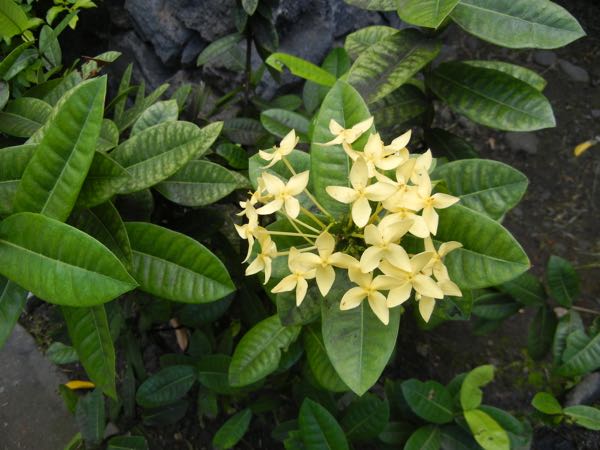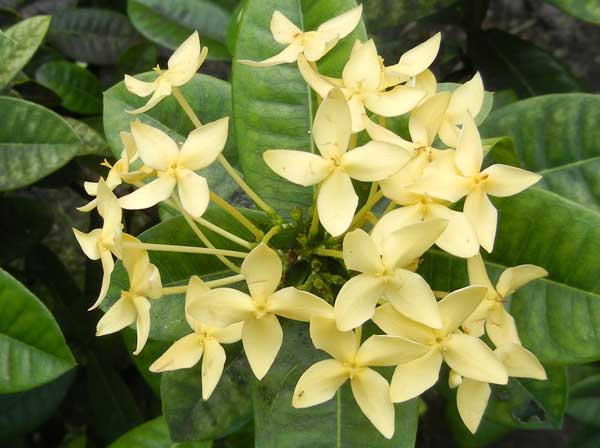Plant Overview: Ixora coccinea ‘Yellow’
Family and Common Names Ixora coccinea ‘Yellow’ is a remarkable member of the Rubiaceae family of plants. It is also recognized by several common names, including Burning Love, Flame Flower, Flame of the Woods, West Indian Jasmine, and Penkduli.
Characteristics and Habitat This vibrant plant is characterized by its multi-branched evergreen shrub structure. It thrives in warm climates and acidic soil, making it ideal for tropical regions. In colder climates, it is commonly grown as a potted plant indoors or as an annual. Ixora coccinea is native to Southern India, Sri Lanka, and Bangladesh. Suriname has even designated it as its national flower. Furthermore, this plant holds significance in Hindu worship and is utilized in Ayurveda, the traditional medicine of India.
Exquisite Flowers and Foliage The allure of Ixora coccinea lies in its remarkable corymbs of florets, which are widely adored. Each tubular flower consists of four delicate petals, exhibiting a dazzling range of colors from orange and red to pink and, in the case of the ‘Yellow’ variety, a bright yellow. The plant’s leaves are equally captivating, boasting a lustrous and leathery texture with a vivid shade of green. With a height ranging from 3 to 8 feet or 90 centimeters to 2.4 meters, Ixora coccinea adds an enchanting presence to any garden or landscape.

Growing and Caring for Ixora coccinea ‘Yellow’:
Pruning: Prune Ixora coccinea ‘Yellow’ annually, preferably in early spring before new growth emerges. This practice helps maintain a compact and well-shaped shrub. Remove any dead or damaged branches and trim back excessive growth to promote a desirable appearance.
Soil and Location: Choose a planting location that provides humus-rich, moist soil with a slightly acidic pH. Avoid planting near concrete structures, as concrete can increase soil alkalinity. Furthermore, refrain from placing the plant under overhangs or near water spouts to prevent leaf damage caused by dripping water.
Fertilization: Regularly fertilize Ixora coccinea ‘Yellow’ to support healthy growth and prolific flowering. Apply a balanced, slow-release fertilizer formulated for acid-loving plants according to the manufacturer’s instructions. Maintaining the appropriate acidic soil pH level is crucial for the plant’s overall health and robust flower production.
Propagation: Propagate Ixora coccinea ‘Yellow’ through softwood and semi-hardwood cuttings. Softwood cuttings are taken from new, flexible growth, while semi-hardwood cuttings come from slightly more mature stems. Prepare the cuttings by removing the lower leaves and dipping the cut ends in the rooting hormone. Plant them in a well-draining propagation mix, ensuring consistent moisture until roots develop.
Pest and Disease Management: Regularly monitor Ixora coccinea ‘Yellow’ for common pests such as aphids, scale insects, and mealybugs. If detected, apply appropriate insecticidal sprays or horticultural oils to control infestations. Be mindful of conditions that may promote the growth of mold and black fungus, such as high humidity. Maintain proper air circulation and avoid excessive moisture on the leaves to prevent these issues.
Name Variations:
Ixora coccinea ‘Yellow’ is known by various names in different countries and regions. In India, it is referred to as “Viruchi,” “Rangan,” “Kheme,” and “Ponna.” Across Southeast Asia, it is recognized as “Chann tanea,” “Techi,” and “Pan.” In Indonesia, popular names include “Siantan,” “Jarum-jarum,” and “Jejarum.” Additionally, in certain regions, it is referred to as “Cruz de Malta.” These diverse names reflect the plant’s widespread popularity and its cultural significance in various parts of the world.




